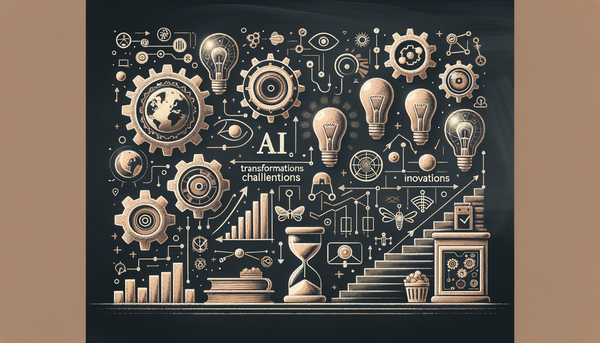AI Updates: Corporate Rivalries, Innovations, and Market Trends

Agentic AI heralds a new era in business innovation, voice technologies are redefining our auditory experiences, and adaptive digital assistants are reinventing user interactions—all while global powerhouses strategize for an AGI future in a fiercely competitive tech landscape.
The Emergence of Agentic AI in Business Operations
Imagine a world where artificial intelligence not only automates routine tasks but also makes complex decisions with minimal human oversight. This isn’t science fiction—it’s the promise of Agentic AI, often dubbed as AI 3.0. Unlike traditional robotic process automation (RPA), which excels in repetitive tasks, Agentic AI fuses large language models with machine learning to interpret data patterns and make autonomous decisions. CFOs and business leaders now have an ultra-smart assistant capable of analyzing market trends, optimizing supply chains, and even guiding customer service improvements.
High-profile companies such as IBM and Tesla are experimenting with Agentic AI to drive innovation in sectors ranging from healthcare to climate modeling. The beauty of this technology is not that it replaces human ingenuity, but that it liberates professionals from routine tasks and frees their time for creative problem-solving and strategic decision-making. I’ve often found that when routine work gets offloaded to technology, we uncover new avenues for innovation that can ultimately transform the way we work.
However, embracing Agentic AI also means navigating challenges—data bias, ethical dilemmas, and potential job displacement are significant concerns. CFO.com’s article on Agentic AI for CFOs explores these complexities and stresses the importance of a cautious yet forward-thinking approach for integration. As noted by Fei-Fei Li,
Technology could benefit or hurt people, so the usage of tech is the responsibility of humanity as a whole, not just the discoverer.
This sentiment underlines why responsible deployment is crucial as businesses leverage Agentic AI to unlock unprecedented levels of efficiency and innovation.
The real beauty of Agentic AI lies in its collaborative power—it works seamlessly with existing RPA systems to create a balanced ecosystem. For instance, while Agentic AI analyzes market data and forecasts trends, RPA tools can execute administrative tasks like invoicing or record keeping. This synergy not only optimizes operational workflows but also ensures that human oversight remains at the core of decision-making processes.
Voice AI Innovations: Google's Chirp 3 and the Future of Auditory Interfaces
While Agentic AI revolutionizes decision-making, another frontier is rapidly expanding—the realm of voice AI. Google’s forthcoming launch of Chirp 3 promises to dramatically extend the capabilities of voice assistants. Set to debut as part of the Vertex AI platform, Chirp 3 introduces eight fresh voices supporting 31 languages, raising the bar for digital auditory interaction.
This innovation reflects a broader trend where voice AI is not limited to simple command-and-response routines but is evolving into a rich spectrum of applications—from conversational agents and interactive audiobooks to sophisticated digital companions. As startups like Sesame push the envelope in developing lifelike voices, Google’s measured rollout underlines a commitment to safety and responsible AI deployment. CEO Thomas Kurian has reiterated that every new feature undergoes rigorous safety assessments, ensuring that the technology is used ethically and effectively.
Developers around the world are already brainstorming imaginative ways to integrate Chirp 3 into their applications. In an era where auditory interfaces are quickly becoming mainstream, this development has the potential to redefine how users interact with technology. Consider the implications: schools could adopt voice-assisted learning programs, while enterprises might leverage enhanced voice recognition to improve customer service.
This careful expansion into voice AI is illustrative of how tech companies are attempting to create immersive environments while mitigating misuse risks and safeguarding user privacy. For further insights on evolving voice technologies, you might explore the discussions on emerging trends in our post on AI news and podcast market trends.
The Evolution of Digital Assistants: Transforming User Engagement with GoatChat.AI
The digital assistant arena has just witnessed a dramatic twist with Adaptive Plus announcing the sale of its renowned AI assistant and digital twin application, GoatChat.AI, to Newry Global Media. Originally designed with students in mind, GoatChat.AI quickly captivated its audience by offering homework assistance, exam preparations, and even features such as creating personalized AI twins and generating vibrant wallpapers.
Boasting a remarkable 8 million downloads and a sustained top-five position on the Apple App Store for an entire year, GoatChat.AI has proven that an integrated digital assistant, when designed thoughtfully, can become an indispensable everyday tool. Under the new stewardship of Newry Global Media—a Spanish media conglomerate with millions of subscribers—the application is poised to evolve beyond educational assistance and enrich everyday digital communications.
This move emphasizes a broader trend: the shifting perception of digital assistants from mere productivity tools to versatile, engaging platforms. As businesses and media houses harness the power of digital twins and AI-driven personalization, the boundary between utility and entertainment continues to blur. Adaptive Plus’s success story underpins the potential for well-crafted AI applications to capture public imagination and create lasting impact.
It’s fascinating to see how a tool initially built for managing academic queries is now positioned as a gateway to a more integrated digital lifestyle. Apple's and Google’s ongoing initiatives in the voice and AI spaces further signal that the future of digital assistants is nuanced, personally engaging, and ever-evolving.
The Strategic Landscape: Winning the AGI Arms Race
Across the globe, enterprises and government bodies are racing towards achieving Artificial General Intelligence (AGI)—a state where AI systems possess the ability to understand, learn, and apply knowledge across a broad range of tasks, much like human cognition. This race is not merely about technological prowess; it encapsulates corporate strategy, ethical implementation, and strategic partnerships.
A recent analysis on AI Wars brings to light how leaders are recalibrating their strategies to emerge victorious in this high-stakes contest. Investment in cutting-edge research, fostering collaborations, and proactive regulatory compliance are indispensable ingredients in this new recipe for success.
From an operational standpoint, embracing AGI means more than just adopting the latest technology—it requires a cultural shift towards continuous learning and ethical experimentation. For example, enterprises must invest not only in technologies but also in talent ecosystems that can leverage these systems effectively. It's a pivot from a traditional infrastructure model to one where adaptability and ethical foresight determine success.
In many ways, this arms race mirrors historical moments of groundbreaking change—the Industrial Revolution and the digital age both saw initial skepticism followed by paradigm shifts that redefined societal norms. The difference today lies in the scale and speed of transformation. The innovation isn’t only in technology but also in how we govern and integrate that technology into everyday life.
Moreover, the competitive tension has spurred a new wave of research and development. Many institutions are now exploring hybrid models that combine narrow AI capabilities with broader AGI frameworks, making headway into areas that were once thought to be the exclusive realm of human creativity and reasoning. As we navigate this complex landscape, it’s crucial to consider that the ultimate race is one for human relevance—ensuring that technology remains a servant of society rather than its master.
Nvidia's Market Influence and Enterprise AI Vision
No discussion about the AI revolution would be complete without addressing the formidable role of Nvidia, a company that has emerged as a juggernaut in the semiconductor industry driving innovations in AI. Nvidia’s CEO has had to defend the company’s AI dominance amid intensifying competition, emphasizing the robustness and versatility of the company’s enterprise-ready solutions.
Nvidia’s continued strides into enterprise AI, including investments in cloud services and specialized hardware, underscore the company's expansive vision. Their strategy reflects a deep understanding of the interplay between hardware and software—a synergy that is fundamental to the future of AI-driven innovations. For instance, Nvidia’s strides were recently elaborated upon in our coverage on Nvidia turning its AI eye to enterprise needs, highlighting the company’s shifting narrative from consumer products to complex enterprise solutions.
Indeed, as enterprises embrace more agentic and adaptive AI systems, companies like Nvidia are critical enablers, providing the computational muscle and innovative tools necessary to translate theoretical potential into tangible business outcomes. Whether it’s processing vast datasets or implementing real-time analytics, Nvidia’s technologies form the backbone of modern AI applications.
This period of rapid development is reminiscent of innovation cycles witnessed in other mature tech sectors—where market leaders must continuously reinvent to stay ahead of emerging competitors. Nvidia’s proactive strategies, supported by robust research and collaborative ventures, maintain their edge in a fiercely competitive environment. As business leaders contemplate the integration of advanced AI platforms, Nvidia’s trajectory remains an instructive blueprint for balancing innovation with market pragmatism.
Apple’s AI Challenges: A Call for Reinvention
Even tech giants are not immune to the challenges of navigating the fast-evolving AI landscape. Apple, proud for its history of design and user-centric innovation, finds itself at a crossroads as it grapples with its AI division’s setbacks. Recent internal discussions, sparked by a delayed and criticized overhaul of Siri, underscore a period of introspection and recalibration within the company.
Reports indicate that a missed timeline for launching the revamped Siri—once hailed as a beacon of Apple Intelligence—has left executives and users alike questioning the company’s direction in the AI domain. The consequences are not just reputational; the delay has spurred concerns over whether Apple can satisfactorily compete with more agile and focused AI innovators in the market.
In a move that appears to blend stubborn resilience with strategic rethinking, Apple’s leadership is now facing the challenge head-on, exploring potential solutions to transform early missteps into a coherent comeback narrative. This scenario is not unique in the tech world; history is replete with examples of companies reinventing themselves after setbacks to dominate their sectors anew. For instance, consider how IBM transitioned from hardware to a dominant force in enterprise software and services.
Nevertheless, the road ahead for Apple's AI initiatives remains fraught with uncertainty. While some industry insiders view the current challenges as temporary hurdles, others call for a radical shakeup in strategy. It will be fascinating to observe whether Apple can harness its storied legacy in innovation to re-establish leadership in the realm of intelligent digital assistants.
Chinese Innovation: Baidu's Bold Leap with ERNIE Models
Across the Pacific, Chinese tech giant Baidu is demonstrating that the AI revolution is a truly global phenomenon. With the recent launch of two new models—ERNIE X1 and ERNIE 4.5—Baidu is positioning itself as a formidable competitor in the AI arena. These models, designed to enhance reasoning and engage in complex dialogues, are a direct response to disruptions caused by competitors like DeepSeek.
The ERNIE X1, promoted as a "deep-thinking reasoning model," offers performance benchmarks similar to leading open-source models but at a fraction of the cost. Coupled with ERNIE 4.5, these models are set to redefine how users interact with digital assistants and chatbots. Baidu’s strategy is a testament to the country’s broader ambition of leveraging innovative technologies to catch up—if not surpass—Western counterparts.
Baidu’s approach is particularly intriguing because it addresses the dual imperatives of affordability and performance. By offering these models at no cost for chatbot users, Baidu is lowering the barriers to entry for widespread adoption and experimentation. This decision could catalyze a wave of innovation, particularly in regions where access to high-end technology has historically been constrained by cost.
Looking at the broader picture, the rise of Baidu’s ERNIE models underscores the increasingly global and democratized nature of AI innovation. In many ways, it mirrors the competitive dynamism seen in other tech sectors, where rapid advancements force companies across continents to continually adapt and improve. The interplay between affordability, performance, and accessibility in Baidu’s new offerings could well be a defining moment in the evolution of conversational AI.
Reflections on a Transformative AI Epoch
The fast-paced evolution of artificial intelligence touches every facet of technology and business today—a sentiment that resonates across sectors. As I reflect on the diverse advancements we’ve seen—from the transformative promise of Agentic AI to Google’s strides in voice AI, and from the dynamic evolution of digital assistants like GoatChat.AI to the heated strategic battle for AGI supremacy—one thing is abundantly clear: we are witnessing a transformative epoch in how technology interacts with human life.
This remarkable progress, however, is not without its challenges. Ethical considerations, data privacy concerns, and the need for continuous innovation serve as important reminders that the future of AI will depend as much on thoughtful governance as on technological breakthroughs. Decision-makers in both the public and private sectors must remain vigilant, ensuring that their pursuit of progress does not compromise the fundamental values upon which our societies are built.
Each breakthrough, whether spearheaded by industry titans like Nvidia and Baidu or reconsidered by stalwarts like Apple, serves as a testament to the relentless drive to innovate. As companies harness AI’s potential to improve efficiency and redefine user experiences, they also need to foster a culture that values human-centric design.
Indeed, the integration of AI into business practices is a symphony of technology and human creativity—a balance between automation and personal touch. As we adopt these remarkable advancements, it is crucial to maintain a dialogue on the ethical, social, and economic implications of technology. By doing so, we pave the way for an AI-powered future that not only enhances productivity but also enriches human experience.
Further Readings
For a deeper dive into the evolving dynamics of Artificial Intelligence and its impact on business and society, consider exploring these AI.Biz articles:
- A Mother’s Heartbreak, AI's Evolution, and Investment Triumphs
- Better AI Buy in the Nasdaq Correction: Nvidia vs. AMD
- Nvidia Turns Its AI Eye To The Enterprise
- Analysts Rethink Stock Price Targets in the AI Race
Each piece contributes a unique perspective on the myriad ways that AI is reshaping our world—inviting readers to join in a discussion that is as much about humanity as it is about technology.
Concluding Thoughts
The narrative of AI continues to evolve, marked by breakthroughs that extend well beyond the laboratory to impact everyday human interactions. From transformative Agentic AI systems that liberate our cognitive potential, to voice technologies that make digital interactions more personable, and digital assistants that morph the way we learn and communicate, the future is already here.
As we stand at the crossroads of technological innovation and human ingenuity, it is imperative for leaders, researchers, and enthusiasts alike to embrace these changes responsibly. The ongoing debates surrounding ethical AI, market dominance, and global competition remind us that the trajectory of AI is a shared responsibility—one that must balance progress with caution, innovation with accountability.
In the grand tapestry of technological evolution, every breakthrough adds a thread to a larger narrative where collaboration, adaptability, and ethical foresight determine our success. Whether you are a CFO contemplating the integration of agentic processes, a developer excited about next-generation voice assistants, or a strategist preparing for the AGI arms race, remember that AI is not merely a tool, but a transformative force shaping the future of human potential.




